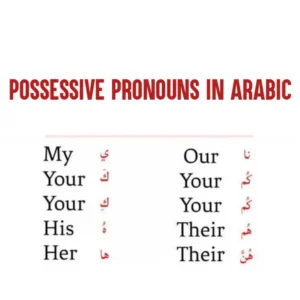Plural In Arabic: A MASTER Guide On Arabic Plurals

In Arabic, the plural form of a word is used to indicate a quantity greater than two. This lesson will help you understand what a plural is in Arabic, explain the different types of plurals, show how to change a singular word to its plural form, and provide examples.
What Is the Word for Plural in Arabic?
The Arabic word for “plural” is جَمْع (pronounced jam‘). In Arabic, words can be singular (مُفْرَد, mufrad), which means one; dual (مُثَنَّى, muthanna), which means two; or plural (جَمْع, jam‘), which means more than two.
Types of Plurals in Arabic
There are two main types of plurals in Arabic:
- Sound Plural (جَمْع السالمِ, jam‘ as-salim): The singular form of the word stays the same, with a suffix added at the end. Sound plurals are divided into:
- Masculine Sound Plural: Formed by adding ـوْنَ (-ūn) or ـيْنَ (-īn).
- Feminine Sound Plural: Formed by adding ـاتٌ (-āt).
- Broken Plural: The word’s internal structure changes to form the plural, with no consistent pattern.
In this lesson, you’ll learn more about these types, see examples, and practice forming plurals from singular words.

Sound Masculine Plural in Arabic
The Arabic term for sound masculine plural is جَمْع المُذَكَّرِ السالمِ (pronounced jam’ al mudhakkar as-salim).
Sound masculine plurals apply to masculine nouns in Arabic, like “Muslimun” (مسلمون). These plurals are called “sound” because they follow a regular pattern when forming the plural.
READ ALSO: Number Of Detached Pronouns in Arabic With Examples
To create a sound masculine plural, you simply add specific endings to the singular noun:
- In the nominative case: Add “ون” (-ūn) to the end of the noun.
- In the accusative and genitive cases: Add “ين” (-īn) to the end of the noun.
However, not all singular nouns can form a sound masculine plural. The noun must meet certain conditions:
- It must be a masculine noun (not feminine).
- It must be singular.
- It must be an adjective describing a rational or living person (a human being).
If the adjective describes something non-living or irrational, the sound plural cannot be formed. Instead, you would use the singular feminine form to express the plural meaning.
Examples Of Masculine Sound Plural
The following table is examples of masculine plural and their corresponding endings.
| Singular | Nominative case | Accusative case | Genitive case | Meaning |
| عَامِلٌ | عَامِلُونَ | عَامِلِينَ | عَامِلِينَ | Worker |
| مُوَظَّفٌ | مُوَظَّفُونَ | مُوَظَّفِينَ | مُوَظَّفِينَ | Employee |
| مُعَلِّمٌ | مُعَلِّمُون | مُعَلِّمِيْن | مُعَلِّمِيْن | Teacher |
| مُزَارِعٌ | مُزَارِعُون | مُزَارِعِيْن | مُزَارِعِيْن | Farmer |
| كَاتِبٌ | كَاتِبُونَ | كَاتِبين | كَاتِبين | Writer |
| مُدَرِّسٌ | مُدَرِّسُونَ | مُدَرِّسين | مُدَرِّسين | Teacher |
| مهندس | مهندسُون | مهندسِين | مهندسِين | Engineer |
| لاَعِبٌ | لاَعِبُونَ | لاَعِبين | لاَعِبين | Player |
| نَاجِحٌ | نَاجِحين | نَاجِحين | نَاجِحين | Successful |
| مَشْهُورُ | مَشْهُورُونَ | مَشْهُورين | مَشْهُورين | Famous |
| مُسْلِمٌ | مُسْلِمُون | مُسْلِمِيْن | مُسْلِمِيْن | Muslim |
| كَافِرٌ | كَافِرُوْن | كَافِرِيْن | كَافِرِيْن | Disbliever |
| خَيَّاطٌ | خَيَّاطُون | خَيَّاطِيْن | خَيَّاطِيْن | Tailor |
| مُقَاتِلٌ | مُقَاتِلُون | مُقَاتِلِيْن | مُقَاتِلِيْن | Fighter |
| مَاهِرٌ | مَاهِرُونَ | مَاهِرين |

Sound Feminine Plural in Arabic
The Arabic term for sound feminine plural is جَمْع المُؤَنَّثِ السالمِ (pronounced jam’ al mu’annath as-salim).
A sound feminine plural is formed by adding “ات” (-āt) to the end of a singular feminine noun without changing its structure or vowels. Essentially, you replace the “ة” (-a) with “ات” (-āt).
The key condition for a noun to be considered a sound feminine plural is that it must have the “ات” suffix. If you remove this suffix, the noun returns to its singular form.
For example, if you remove “ات” from the word “فَاطِمات” (Fāṭimāt), you get back the singular form “فاطِمَة” (Fāṭima).
Sound feminine plurals always end with “ات”, regardless of their position in the sentence. The grammatical case endings for these nouns are the same as those for singular nouns: Dhammah if nominative, and Kasrah if accusative or genitive.
Examples Of Sound Feminine Plural
The following table is examples of sound feminine plural and their corresponding endings.
| Singular | Plural | Meaning |
| طَالِبَةٌ | طَالِباتٌ | Student (f) |
| طَالِبَةٌ | مُمَرِّضاتٌ | Nurse |
| طَبِيبَةٌ | طَبِيبَاتٌ | Doctor |
| فَاطِمَةُ | فَاطِماتٌ | Fatima |
| جَيِّدَةٌ | جَيِّداتٌ | Good |
| مُهَنْدِسَةُ | مُهَنْدِسَاتُ | Engineer |
| زَّوْجَةُ | زَّوْجَاتُ | Wife |
| مدِيرَةُ | مدِيرَاتُ | Headmistress |
| مُدَرِّسَةَ | مُدَرَّسَاتِ | Teacher |
| وَفِيَّةٌ | وَفِيَّاتٌ | Faithful |
| نَشِيطَةٌ | نَشِيطَاتٌ | Active |
| مُسْلِمَةٌ | مُسْلِمَاتٌ | Muslimah |
| مُعَلِّمَةٌ | مُعَلِّمَاتٌ | Teacher |
Broken Plural in Arabic (Irregular Plurals)
What is a broken plural in Arabic?
The Arabic term for broken plural is جَمْعُ التَّكْسِيْر (pronounced jam’ at-taksir). In a broken plural, the singular form of the word is “broken” or changed to make the plural. There isn’t a fixed rule for how to form these plurals.
Sometimes, letters are added or removed, and other times, only the vowels (harakat) are changed.
Broken Plural In Arabic Examples
Here are some examples of broken plurals in Arabic.
| Singular | Plural | Meaning |
| حَبْل | أَحْبُل | Rope |
| بَحْر | أَبْحُر | Sea |
| بَيْتَ | أَبْيَات | House |
| ثَوْب | أَثْوَاب | Garment |
| وَصْف | أَوْصَاف | Description |
| وَقْت | أَوْقَات | Time |
| جَمَل | أَجْمَال | Camel |
| عَلَم | أَعْلام | Flag |
| قَلْب | قُلُوب | Heart |
| عِلْم | عُلُوم | Science |
| طَعَام | أَطْعِمَة | Food |
| مَرِيْض | مَرْضَى | Patient |
| صَعْب | صِعَاب | Difficult |
| عِنَب | أَعْنَاب | Grape |


Verbal Plurals in Arabic
In Arabic, verbs can have plural markers:
- For sound masculine plurals: Use “ون” (-ūn).
- For sound feminine plurals: Use “نْ” (-n).
When a verb is in the subjunctive or jussive mood:
- Sound masculine plural marker “ن” is replaced with “ا” (ā).
- Sound feminine plural marker “نْ” stays the same.
Examples:
- Indicative Mood:
- يُعَالِجْن (yu‘ālijna, they treat)
- يَكْتُبْنَ (yaktubna, they write)
- يِشْرَحُون (yashraḥūn, they explain)
- Subjunctive Mood:
- يُعَالِجْن (yu‘ālijna)
- يَكْتُبْنَ (yaktubna)
- يِشْرَحُوا (yashraḥū)
- Jussive Mood:
- عَالِجْنَ (‘ālijna)
- يَكْتُبْنَ (yaktubna)
- اِشْرَحُوا (ishraḥū)
The plural marker (like “ون”, “وا”, or “نْ”) appears on the verb only if the plural noun comes before the verb. If the noun is after the verb, the verb remains singular.
Examples of Plurals:
- Friends: أصْدِقاء (asdiqā’) – a broken plural.
- Book: كُتُب (kutub) – a broken plural.
- Chair: كَرَاسِي (karāsī) – a sound feminine plural.
- Big: Common plurals are كِبَار (kibār), كُبَرَاء (kubarā’), كَبِيرَات (kabīrāt), or كَبَائِر (kabā’ir).
- Room: غُرَف (ghuraf) – a broken plural.






